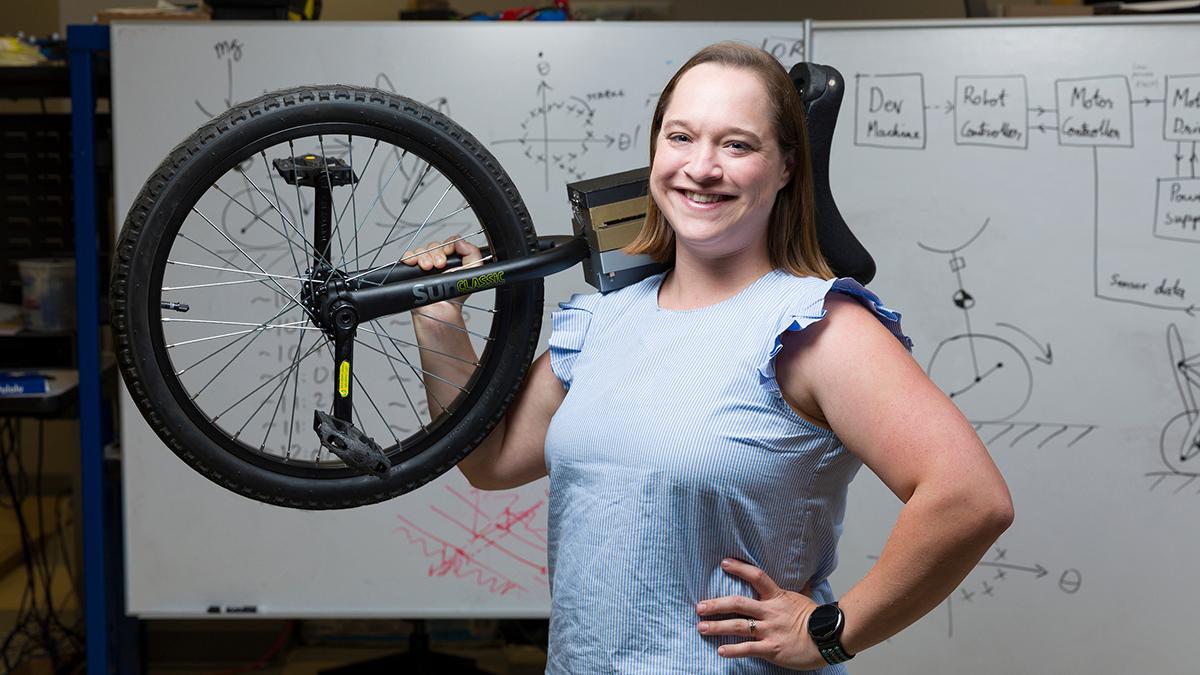
Taylor Higgins, Ph.D., an assistant professor of mechanical engineering at Florida State University and the joint FAMU-FSU College of Engineering, poses with her unicycle at the Center for Intelligent Systems Control and Robotics (CISCOR) in the Aero-Propulsion Mechatronics & Energy (AME) building in Tallahassee, Florida on July 1, 2025. Higgins received a National Science Foundation (NSF) Mind, Machine, and Motor Nexus (M3X) grant to further understanding of human motor learning and its applications in movement-assistive robotic technologies.
Mechanical engineering team develops intelligent robotic systems that adapt to individual learning patterns, potentially transforming physical therapy outcomes for stroke survivors and mobility-impaired patients.
The path to recovery for stroke survivors taking their first tentative steps, or individuals navigating daily challenges from balance disorders, often feels overwhelming. But ground-breaking research at the FAMU-FSU College of Engineering offers new hope through innovative human-robot collaboration.
AI-Driven Robotic Learning Systems Transform Rehabilitation
Researchers are exploring the intricate world of human motor learning, harnessing cutting-edge artificial intelligence to create adaptive robotic rehabilitation systems. These aren’t just machines—they’re intelligent partners in movement recovery, providing personalized support as individuals reclaim their independence.
“Our goal is to explore how humans learn complex balance tasks and how assistive robotic devices can facilitate that process,” explains Taylor Higgins, a mechanical engineering researcher. “By simulating paired robotic agents—a ‘student’ learning while a ‘coach’ guides—we can gain insights into the mechanics of human learning and adapt our technologies to serve rehabilitation needs better.”
The innovative approach focuses on gradual independence. As patients progress through rehabilitation stages, they require less robotic assistance over time.
Breakthrough Unicycle Model Enhances Safety in Physical Therapy
Traditional rehabilitation involves high-risk movements like walking, where human dynamics create significant challenges for conventional intervention methods. Higgins’ team addresses this by employing a novel single-wheel vehicle model that simplifies balance and propulsion studies while maintaining research effectiveness.
“It’s really hard to get a robot to walk on two legs at all,” Higgins explains. “The problem gets that much harder when you have to guide a human through the learning process at the same time. So, we are using a simpler mathematical model that allows us to focus more on how the robot is engaging with the human.”

The researchers utilize an innovative unicycling mathematical model rather than complex walking algorithms. This approach proves more effective because the wheel maintains constant ground contact, enabling researchers to gather essential data while focusing on robot-human learning interactions.
Addressing Psychological Barriers in Recovery
“Our aim is to create robotic assistance that not only supports physical rehabilitation but also addresses the psychological factors at play, such as the fear of falling,” Higgins notes.
Developing adaptive robotic controllers that accelerate new skill acquisition through machine learning algorithms is central to the research.
“A controller is basically just the math that determines how the robot will behave,” Higgins said. “In this research we want the behavior of the robot to change in response to the hu-man’s learning. We want the robot to adapt to provide the physical interactions that will best guide the learner along the path to skill acquisition.”
Interdisciplinary Collaboration Drives Innovation
The team aims to establish a comprehensive robotic assistance testbed that evaluates human physiological and cognitive responses during learning processes. This innovative methodology will refine assistive technologies that enhance human learning and rehabilitation outcomes.
Higgins collaborates with leading experts, including Brady DeCouto, an assistant professor from the FSU Anne Spencer Daves College of Education, Health, and Human Sciences specializing in human motor learning, who studies the human learning process independently of robotic involvement. Shreyas Kousik, an assistant professor from Georgia Tech and an authority in machine learning for robotics, focuses on robot behavior through reinforcement learning perspectives. Higgins integrates all results to ensure robotic systems function effectively for real-world human applications.
Transforming Lives Through Intelligent Robotics
The research potential extends far beyond engineering—impacting countless individuals facing mobility challenges. This work could revolutionize movement rehabilitation and establish new paradigms in human-robot interaction.
“We aim to reduce the time required for rehabilitation through intelligent robotic support,” Higgins emphasizes, focusing on improved health outcomes and quality of life enhancement.
Higgins, an assistant professor at the FAMU-FSU College of Engineering leading the study, has been awarded a $798,706 grant from the National Science Foundation’s Mind, Machine, and Motor Nexus (M3X) program through Florida State University. The funding supports this transformative research to enhance understanding of human motor learning and its applications in movement-assistive robotic technologies.
With this NSF support, Higgins positions herself at the forefront of an emerging field integrating human learning, artificial intelligence, robotics, and healthcare innovation.
Editor’s Note: This article was edited with a custom prompt for Claude Sonnet 4, an AI assistant created by Anthropic. The AI optimized the article for SEO discoverability and improved clarity, structure and readability while preserving the original reporting and factual content. All information and viewpoints remain those of the author and publication. This article was edited and fact-checked by college staff before being published. This disclosure is part of our commitment to transparency in our editorial process. Last edited: 07/29/2025.
RELATED ARTICLES
New Research Challenges Traditional Approach to Human-Robot Interaction
Mechanical Engineering Major Combines Compassion and Innovation in Prosthetic Design
